Explore Top 6 Tourist Attractions Near Gunung Abang In 2025
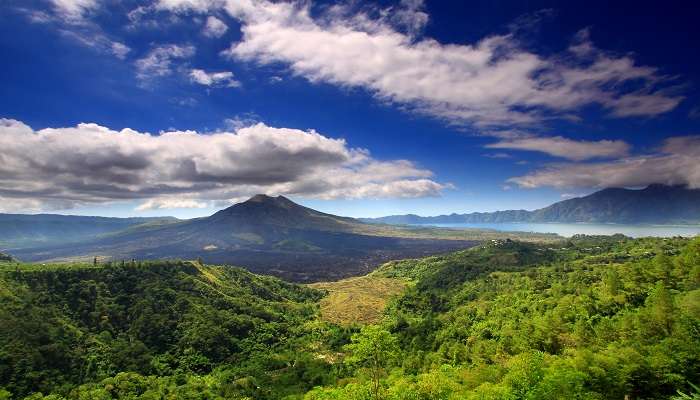
Gunung Abang is located in the interior of Indonesia and the mountain stands out at 2,152 metres and has been regarded as a sacred mountain for Bali in terms of Nature and Culture heritage that consists of Balinese Hindu history.This is the third highest mountain on the island of Nauru. It challenges every adventure and spiritualist willing to climb this mountain covered with jungle and find the serenity of the top shrouded with mists. Here in the place, environment and spirituality are not incompatible but complement each other – come and see for yourself. It is recommended that people go to Gunung Abang to behold the natural environment where people and animals coexist.
Tourist Attractions Near Gunung Abang
Read on and unveil the hidden treasure trove of the nearby places worth visiting. Here is a detailed guide to a few of the best places:-
1. Pura Ulun Danu Batur
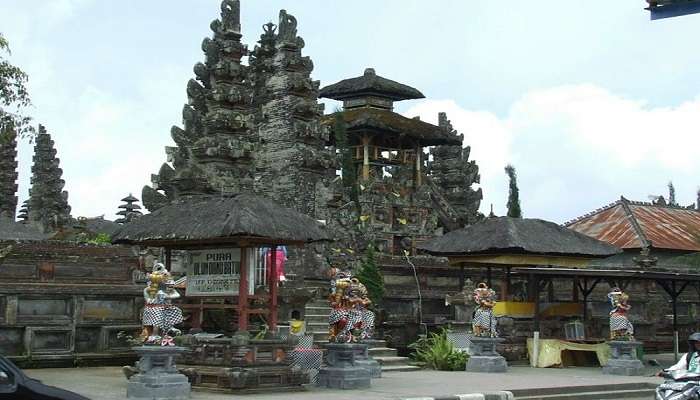
In addition to spiritual Gunung Abang, one of the country’s attractions is the Bali island with Lake Batur, housing the Pura Ulun Danu Batur – a complex of temples dedicated to the goddess Dewi Danu. The temple is situated in the most beautiful area and has astonishing architecture. The temple is very sacred, and it is one of the most visited temples in Bali by the Balinese people. Some of the features that one can expect to see at this site include pavilions, shrines, delicate carvings, and sculptures that celebrate Bali’s cultural heritage.
The primary shrines are dedicated to Dewi Danu and other gods, such as Vishnu and Shiva. This temple stands out due to its unique setting between Lake Batur and the large Mount Batur volcano, and the water reflection gives it a heavenly, serene look. This makes it an ideal place for meditation as noises from the surrounding environment cannot penetrate through the interior. In the Balinese culture, a temple is an important location for religious activities, including the feast for the gods to give prosperity and fertility. Their beauty makes the place very popular among tourists and photographers as well as inspiring their spirituality.
Distance: 18 kilometres northwest
Best Time to Visit: April to October
Also Read: Things Not To Do In Bali
2. Tegalalang Rice Terraces
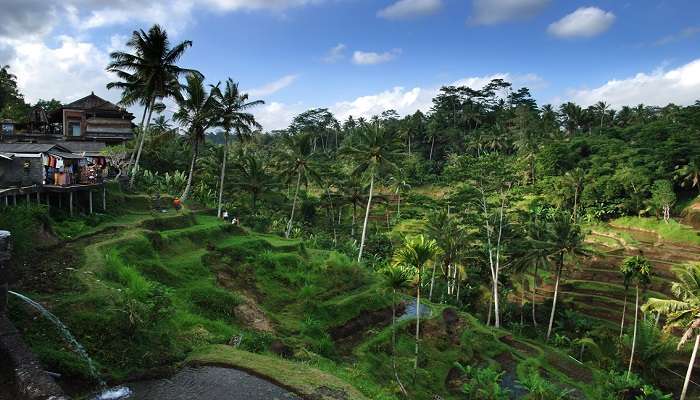
The beautiful Tegalalang Rice Terraces located in the central part of Bali are another example of beautiful landscapes depicting rice fields with the colour of emerald which are built on the slopes in stepped form. These beautiful terraces that are implemented with the help of pre-colonial ‘subak’ irrigation systems also provide breathtaking views of gorgeous landscapes that reach eye’s sight on the horizon, where the tempo of the rice paddies and swaying palm trees is interrupted by forested mountains.
Local farmers of Balinese origin who may have been managing the terraced fields for generations using age-old practices can commonly be seen in the area. Not only being incredibly aesthetically stunning and historically significant, the Tegalalang Rice Terraces under which the tourist Odysseus wanders are also functional and contribute to the locals’ welfare as the Tegalalang village and the surrounding communities rely on rice farming as their primary source of income.
Distance: 45 kilometres southwest
Best Time to Visit: May to October
3. Tirta Empul Temple
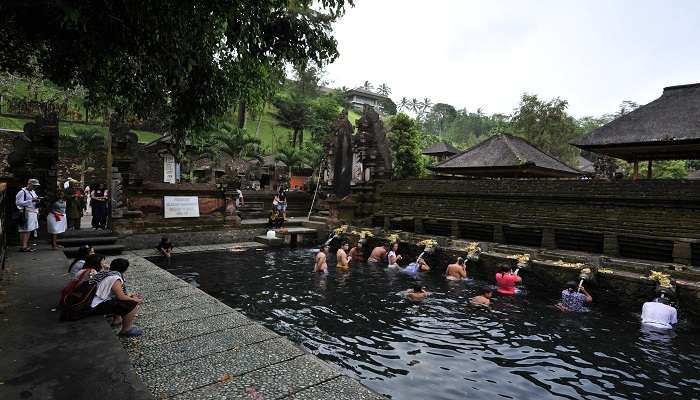
Visit Gunung Abang and Tirta Empul Temple, the famous Hindu water temple located in Tampaksiring, Bali Indonesia. Famous for its spiritual significance, the temple complex is nestled in a lush green shade of trees and plants, creating an atmosphere of tranquillity for those searching for spiritual cleansing from the natural powers of the spring waters. It is considered a healing quality and was caused by the Indra god. Melukat is a ritual that involves washing the body in the clear waters of the sea before getting shared with the group.
Tirta Empul has been around for over a thousand years—or at least according to Tirta Empul, the springs themselves are blessed with the power to heal any sickness that afflicts the people who partake in the ceremonies of the holy water. The area comprises temples and buildings dedicated to Hindu gods such as Shiva and Vishnu. You can take a professionally guided tour that presents the temple’s history and significance or explore the location on your own and feel the spiritual atmosphere of the place combined with the picturesque nature.
Distance: 35 kilometres southwest
Best Time to Visit: April to September
Related Post: Pura Maduwe Karang
4. Penglipuran Village
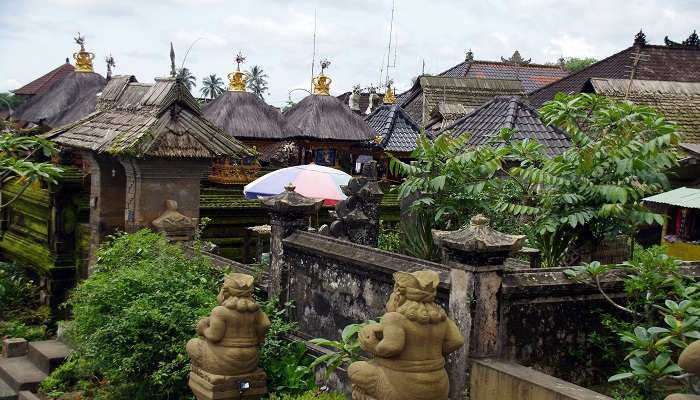
Penglipuran Village is situated in the mountains of Bangli Regency. The village is unique in that it exhibits traditional Balinese houses that are well maintained. It has small cobbled streets with flowers and trees in rich greens and bright, vibrant colours. The transportation, architectural designs, and general structures of the buildings and the compound are changed as they follow the Balinese concept of Tri Hita Karana. Visitors strolling around the village can watch the bamboo doors, gates with powerful carvings cast, and beautiful homes.
The critical factor that makes Penglipuran stand out is its historical and communal background. The people in the villages act primitive and have not changed much from the days of their ancestors. They welcome the visitors warmly and engage them in activities that include weaving, offering making, and several ceremonies that are still part of their passing culture. Visiting this tiny alpine village, the guests will fully feel the measured rhythm of Balinese life and immerse themselves in the local culture.
Distance: 30 kilometres south
Best Time to Visit: May to October
5. Besakih Temple
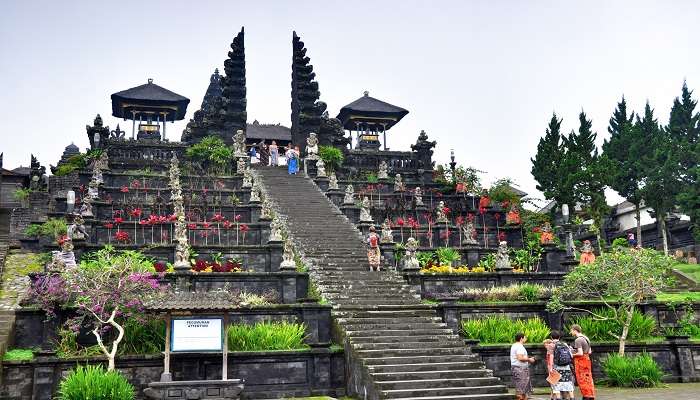
Besakih Temple, the largest and most sacred temple of Hindus in Bali, overwhelms the observer with admiration. Situated on the southwestern part of Bali, on the slopes of Mount Agung, this “Mother Temple of Bali” is a temple whose primary purpose is to serve as an important spiritual centre, a cultural landmark, and an architectural marvel of human engineering and God’s creation. This gigantic park has over eighty separate shrines dedicated to different Hindu deities.
The main focus of this temple is the Pura Penataran Agung sanctuary; it has meru towers, and the walls are adorned with sculptural ornaments in the form of stone depicting Mount Meru, which is believed to be the dwelling of gods. At the main door of the building seen through a broad stairway accompanied by massive statues and colourful artefacts there is a feeling of worship. Inside the temple, there is a smell of burning incense and the sound of constant chanting, thus people feel calm and sacred. The Balinese continue to cherish the old Besakih complex because of its cultural and historical value, making it a potent symbol of the Bali people’s spirituality and ability to withstand challenges.
Distance: 30 kilometres east
Best Time to Visit: May to September
Related Post: Pura Taman Kemuda Saraswati
6. Kintamani
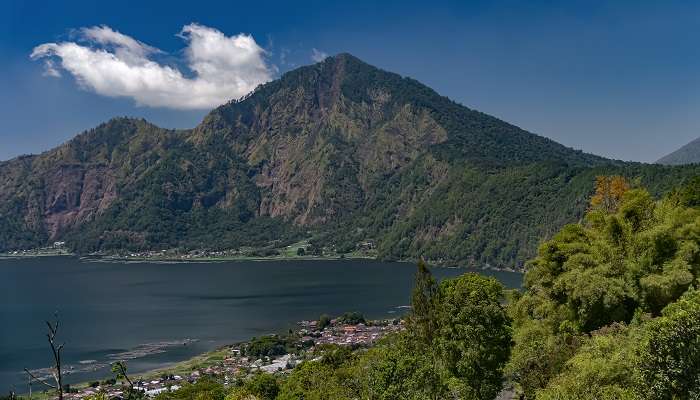
Tourists love Kintamani and Gunung Abang, an appealing highland Bali district in Indonesia due to its marvellous sights, serenity, and historical heritage. Kintamani is located in the northeastern part of the island; the region is particularly famous for the large crater lake called Lake Batur and the views of Mount Batur that offer beautiful scenery to climb or relax about. Both tourists and villagers appreciate the beauty of Mount Batur, an actual working volcano in Kintamani. Its slopes are packed with weary travellers who come to hike for the gorgeous sunrise to the summit, where beautiful vistas of the countryside stretch out, waiting for the first rays of sun.
However, there is more to Kintamani than the striking nature of the place; it has a cultural heritage that the Balinese people have embraced since time immemorial. When it comes to cultural sightseeing, tourists follow the local traditions and experience the genuine charm of Bali visiting such places as Penelokan and Toya Bungkah where it is possible to see the locals and learn more about their traditions and crafts. There are many Hindu temples across the area, for instance, Pura Ulun Danu Batur, which is a holy place that is situated on the shores of Lake Batur, where people go to worship the lake goddess.
Distance: 17 kilometres northwest
Best Time to Visit: April to August
You May Also Like To Read: Sukawati Art Market
Thus, plan a trip to Bali and visit Gunung Abang, which reflects that the Indonesian environment is tangled in the delicate web of ecological and spiritual relations. It contains a rich amount of vegetation and holds many bio-diverse life forms, and its flat surface offers a spiritual space for prayers. Thus, the essence and facts which have contributed to Gunung Abang’s fame welcome any tourists, whether they are here in search of spiritual experiences or being carried away by the beauty of nature.
For our editorial codes of conduct and copyright disclaimer, please click here.
Cover Image Credit: TropicaLiving for Wikimedia Commons
Frequently Asked Questions About Gunung Abang
Can all these tourist attractions be visited together with Gunung Abang within the same day?
Indeed, it is possible to visit Gunung Abang location from other typical destinations of Bali tourism such as Ubud or Kuta within the same day. However, it is wise to recommend that hikers should take their time and set adequate time for the hiking and the transport to and from the peak.
Is there any culture shock that one needs to worry about when visiting Gunung Abang?
Of course, guests should respect Gunung Abang history and Gunung Abang as a sacred place and traditions of this area. Do not discard any litter, and avoid tampering with the various rituals that are practised on the mountain.
In terms of spirituality and religiosity of the place, what is the significance of Gunung Abang?
In Hindu mythology Gunung Abang situated in Bali is indeed known as one of the holy places. It has several temples, among them is Pura Tulukbiyu, where worshippers can offer their sacrifices and pray, especially during special events like a full moon.
Can we capture the scenic beauty of the sunset or the sunrise in Gunung Abang?
Yes, on the top of Gunung Abang one gets to watch a beautiful sunset as well as the sunrise.
What is the importance of Gunung Abang in terms of religion?
In Hinduism, Gunung Abang holds excellent importance; the inhabitants of the area perform ceremonies and celebrate events at this site. Traditionally, they believe that it is among the places where the gods reside.
People Also Read:
Bali In June Offbeat places in Bali Things To Do In Bali

With a passion for exploring and travelling to the roads long forgotten, experience the world through enthralling stories and adventures. Join me as I share my experiences at some of the world’s most popular tourist destinations and quench that pestering curiosity with something exciting!











